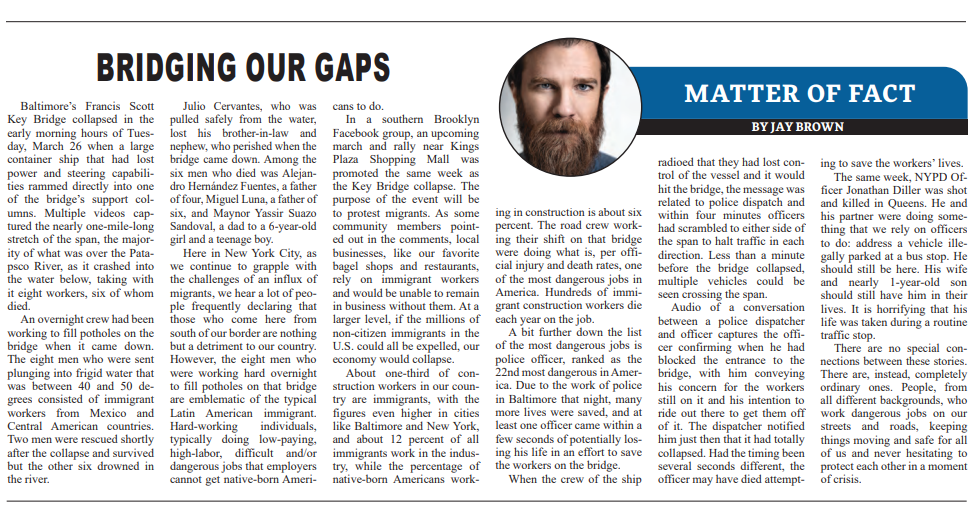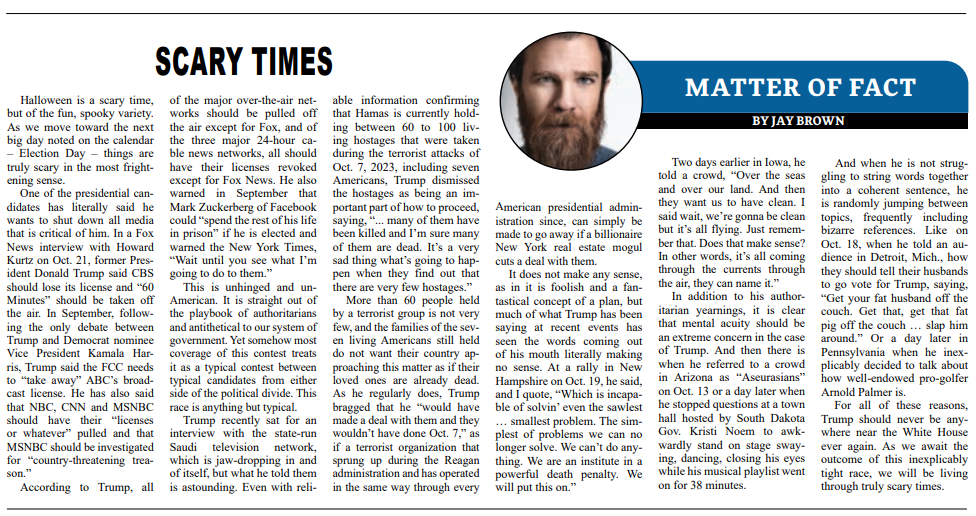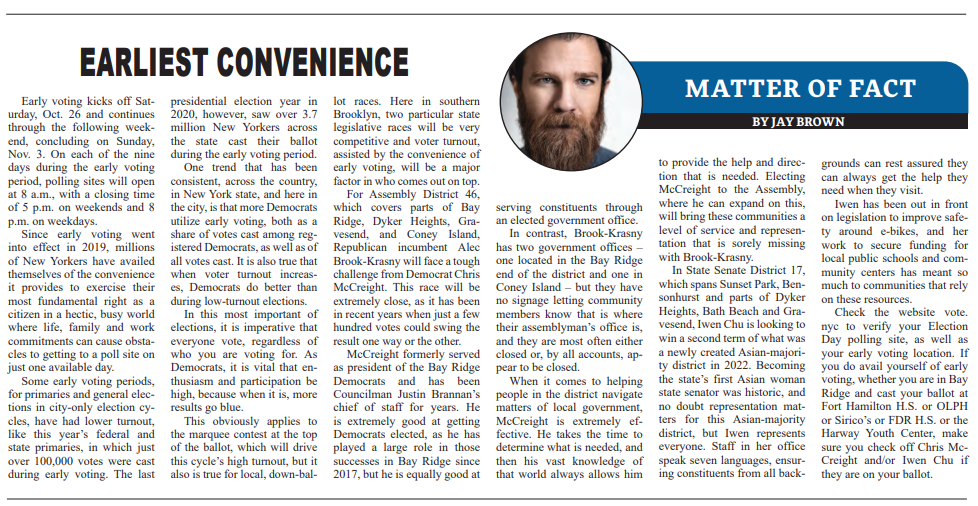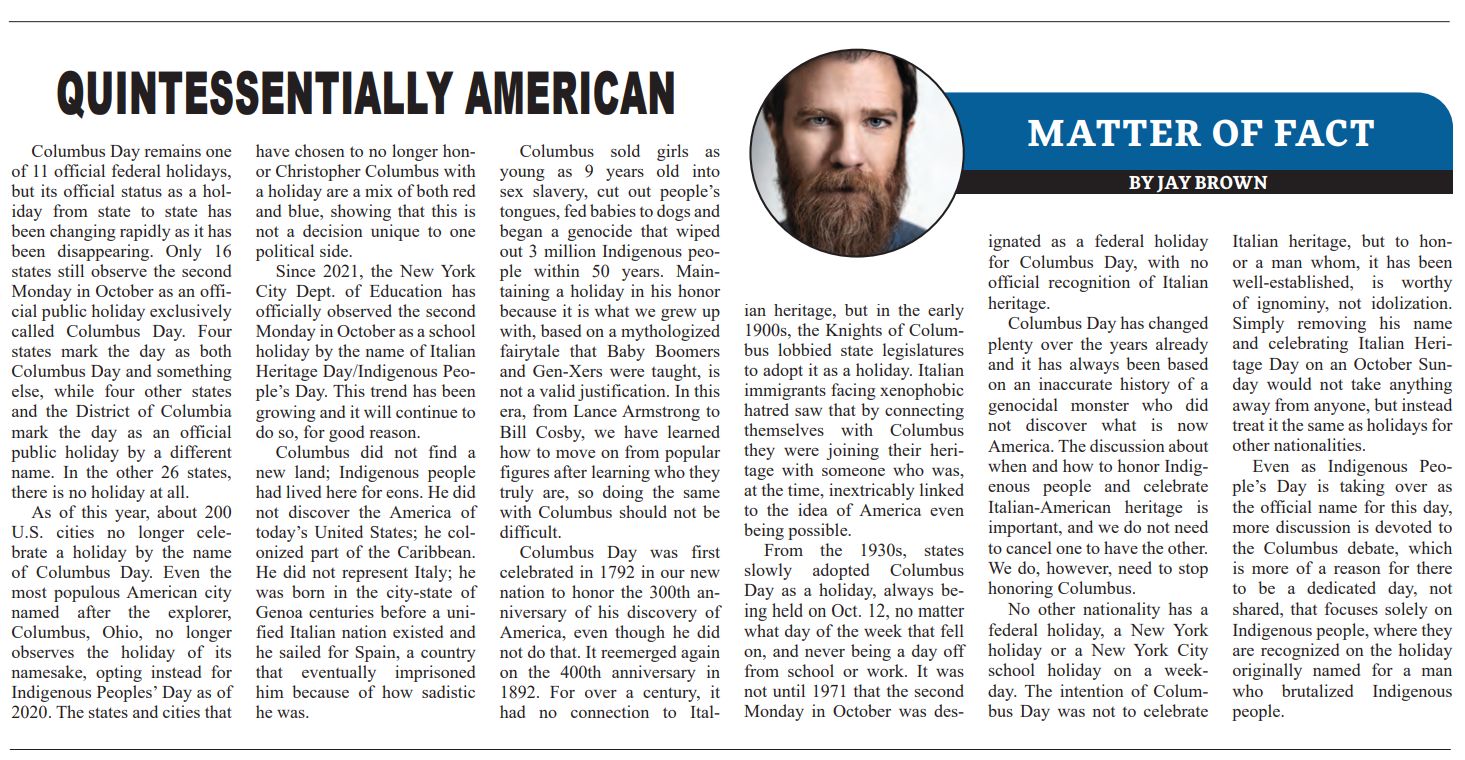This column, from the weekly opinion piece MATTER OF FACT, first appeared on BrooklynReporter.com, the Home Reporter and Spectator dated April 5, 2024
Baltimore’s Francis Scott Key Bridge collapsed in the early morning hours of Tuesday, March 26 when a large container ship that had lost power and steering capabilities rammed directly into one of the bridge’s support columns. Multiple videos captured the nearly one-mile-long stretch of the span, the majority of what was over the Patapsco River, as it crashed into the water below, taking with it eight workers, six of whom died.
An overnight crew had been working to fill potholes on the bridge when it came down. The eight men who were sent plunging into frigid water that was between 40 and 50 degrees consisted of immigrant workers from Mexico and Central American countries. Two men were rescued shortly after the collapse and survived but the other six drowned in the river.
Julio Cervantes, who was pulled safely from the water, lost his brother-in-law and nephew, who perished when the bridge came down. Among the six men who died was Alejandro Hernández Fuentes, a father of four, Miguel Luna, a father of six, and Maynor Yassir Suazo Sandoval, a dad to a 6-year-old girl and a teenage boy.
Here in New York City, as we continue to grapple with the challenges of an influx of migrants, we hear a lot of people frequently declaring that those who come here from south of our border are nothing but a detriment to our country. However, the eight men who were working hard overnight to fill potholes on that bridge are emblematic of the typical Latin American immigrant. Hard-working individuals, typically doing low-paying, high-labor, difficult and/or dangerous jobs that employers cannot get native-born Americans to do.
In a southern Brooklyn Facebook group, an upcoming march and rally near Kings Plaza Shopping Mall was promoted the same week as the Key Bridge Collapse. The purpose of the event will be to protest migrants. As some community members pointed out in the comments, local businesses, like our favorite bagel shops and restaurants, rely on immigrant workers and would be unable to remain in business without them. At a larger level, if the millions of non-citizen immigrants in the U.S. could all be expelled, our economy would collapse.
About one-third of construction workers in our country are immigrants, with the figures even higher in cities like Baltimore and New York, and about 12 percent of all immigrants work in the industry, while the percentage of native-born Americans working in construction is about six percent. The road crew working their shift on that bridge were doing what is, per official injury and death rates, one of the most dangerous jobs in America. Hundreds of immigrant construction workers die each year on the job.
A bit further down the list of the most dangerous jobs is police officer, ranked as the 22nd most dangerous in America. Due to the work of police in Baltimore that night, many more lives were saved, and at least one officer came within a few seconds of potentially losing his life in an effort to save the workers on the bridge.
When the crew of the ship radioed that they had lost control of the vessel and it would hit the bridge, the message was elated to police dispatch and within four minutes officers had scrambled to either side of the span to halt traffic in each direction. Less than a minute before the bridge collapsed, multiple vehicles could be seen crossing the span.
Audio of a conversation between a police dispatcher and officer captures the officer confirming when he had blocked the entrance to the bridge, with him conveying his concern for the workers still on it and his intention to ride out there to get them off of it. The dispatcher notified him just then that it had totally collapsed. Had the timing been several seconds different, the officer may have died attempting to save the workers’ lives.
The same week, NYPD Officer Jonathan Diller was shot and killed in Queens. He and his partner were doing something that we rely on officers to do: address a vehicle illegally parked at a bus stop. He should still be here. His wife and nearly 1-year-old son should still have him in their lives. It is horrifying that his life was taken during a routine traffic stop.
There are no special connections between these stories. There are, instead, completely ordinary ones. People, from all different backgrounds, that work dangerous jobs on our streets and roads, keeping things moving and safe for all of us and never hesitating to protect each other in a moment of crisis.




